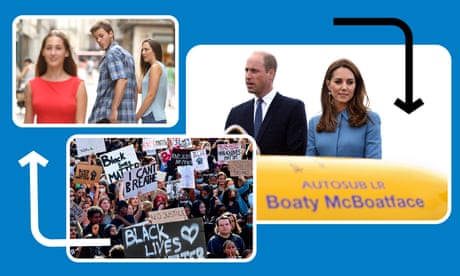- by foxnews
- 08 Apr 2025
What Elon’s giving up: Twitter’s best moments - from Boaty McBoatface to Trump’s ban
What Elon’s giving up: Twitter’s best moments - from Boaty McBoatface to Trump’s ban
- by theguardian
- 13 Jul 2022
- in technology

In April, when Elon Musk announced plans to buy Twitter, the platform's users instantly divided into two clear camps: those who thought that Musk would ruin Twitter, and those who understood that it was already pretty dreadful. Now that Musk has said he is walking away from the deal, a third group is complaining that without an injection of go-getting, Musk-style disruption the platform is doomed to irrelevancy.
Everyone needs to calm down. While Twitter does now primarily operate as a receptacle for the world's angriest people to scream their least thought-out arguments at each other around the clock, it can still also be a force for good. Since its inception, Twitter has proved that it is brilliant at two key things: accelerating social change, and illuminating the depths of human stupidity. Here are 10 standout moments from Twitter history.
On 2 March 2014, during an otherwise interminable Oscars ceremony, host Ellen DeGeneres ploughed into the midst of the assembled A-listers and demanded a group selfie. DeGeneres immediately tweeted the resulting photograph, which quickly became the most widely retweeted in history. The selfie has subsequently dropped to fifth place (behind the announcement of Chadwick Boseman's death, two tweets by a Japanese billionaire looking to give away his fortune and a man attempting to get a year's supply of chicken nuggets). By photographic standards the selfie is unforgivably inept - Angelina Jolie is obscured by her own hand, Jared Leto is barely in the frame and everyone looks several million miles from their best - but in retrospect that's all part of its charm.
When a stream of women accused Harvey Weinstein of sexual harassment and rape in 2017, Twitter quickly united. The stories about Weinstein were relentless and difficult to hear, but they inspired a flood of women from all walks of life to share their own experiences. Activist Tarana Burke officially created the term Me Too and had been using it since 2006. But when actor Alyssa Milano tweeted it in the wake of Weinstein's downfall, it caught on. #MeToo can genuinely claim to have changed things for the better. Social media is a terrible invention for countless reasons but, by demonstrating the power of giving ordinary people a voice, it also proved that it isn't entirely bad.
In 2017, we were treated to the most perfect summary of online discourse. A man and a woman walk down the street. Another woman walks past. The man, temporarily forgetting himself, turns around and checks out this sexy new stranger, while his companion stares at him in disbelieving anger. The image itself came from a 2015 stock series photographed by Antonio Guillem in Catalonia (combined, they form a story about infidelity told "in a fun and playful way"), but that isn't important. The internet has awarded the image its definitive meaning, which is unwarranted distraction. We obsess over celebrities while forgetting about climate change. We should be putting our focus into politics, but instead we're mucking about online. The outrage on the woman's face is what we should be feeling. The horniness on the man's face is who we really are. It's superego and id. It's all of humanity in a single shot. It is perfect.
Black Lives Matter began in 2013, as a hashtag that gained traction when George Zimmerman was acquitted of the second-degree murder of 17-year-old Trayvon Martin. However, the movement roared back in May 2020, when video footage emerged of a Minneapolis police officer kneeling on a Black man's neck until he died. The video of George Floyd's murder was instantly shared around the world, and three days later the #BlackLivesMatter hashtag was used 8.8m times in the space of 24 hours. Such was the firestorm of outrage that real-world protests followed by their thousands in the US, with hundreds more happening internationally. If you want to see the power of a single hashtag, this is where to look.
It remains to be seen whether Donald Trump was a weird blip in America's history or a dark harbinger of worse things to come, but there's no denying that he made his reputation on Twitter. For years before his presidential run, he used Twitter the same way that everyone else does: by making a series of fast-twitch reactions about things he knew little about. When he became president, his attacks became louder and more violent, to the point that Twitter had to invent in-tweet clarifications to factcheck his wildest claims. In the end, the events of January 6 2021 did for him. Trump was banned for making a video where he said "We love you, you're very special" to a group of people who at that exact moment in time were attempting to stage an insurrectionist coup. The good news is that Donald Trump is no longer on Twitter.
Looking back, the dress seems to be one of those moments where humanity as a whole simultaneously lost its mind. The history of the tweet is this: in 2015, a woman named Cecilia Bleasdale went to the Cheshire Oaks discount shopping village and took a photo of a dress she liked and sent it to her daughter. However, mother and daughter disagreed on what colour it was: one said it was blue and black, the other said it was white and gold. The daughter then shared it on Facebook, as part of a quick straw poll to see who was right. But when the dress made the leap to Twitter, things exploded. In a very Twitterish manner, people quickly decided upon the colour of the dress, before declaring that anyone who disagreed with them was a hateful idiot. Within a week, the dress had been tweeted about 10m times, and neuroscientists began to explore the reason for everyone's differing perceptions. However, at least the dilemma has a definitive answer. Roman Originals, which sold the dress, listed it as royal blue. As such, anyone who thought it was white and gold can suck it.
Beginning in 2010, a series of protests swept through the Arab world, as thousands of citizens frustrated by political corruption and financial stagnation took to the streets in an effort to overthrow their governments. Protesters found themselves using Facebook and Twitter to both coordinate their protests and amplify their cause around the world. Thrillingly, it worked. Leaders in Tunisia, Egypt, Yemen and Libya were ejected by the protests. By getting rid of Muammar Gaddafi, the Arab spring achieved something that the west spent decades fruitlessly dreaming about. The legacy of the uprisings may be complicated but this was the moment when the world woke up to Twitter's potential.
Many of us who have been on Twitter for a very long time agree that it is tremendously difficult to replicate the freewheeling spirit of its early days. Over the years the platform has devolved into a space where people (and, worse, brands), can complain about the same thing around the clock. But sometimes there will be a news story so unexpected, and so completely irresistible, that it brings out the best in everyone. The perfect example is the claim by Michael Ashcroft, in his book Call Me Dave, that former prime minister David Cameron had - while at university - "put a private part of his anatomy" into the mouth of a dead pig as part of a gruesome initiation ceremony. Imagine it. Imagine everyone on Earth learning this at the same time, and getting to see them process it in public. The Christmas morning of Twitter.
In 2016, the UK's Natural Environment Research Council wanted to name a new �200m polar scientific research ship, and thought that it might be a fun thing to ask the internet to choose the name. Traditionally, vessels like this are given sweeping names that conjure memories of empire. However, BBC Radio Jersey presenter James Hand decided to submit "Boaty McBoatface" as an option and, after the name went viral on Twitter, that's what everyone picked. NERC initially tried to downplay the public vote, but the public would not be swayed. This is what they picked and, by God, this is what the boat should be called. And so a compromise was reached whereby an autonomous robotic submarine was called Boaty McBoatface instead of the research ship. The lesson was clear: never, ever let the public decide anything. Sadly this was a lesson that nobody really understood until after Brexit.
- by foxnews
- descember 09, 2016
Ancient settlement reveals remains of 1,800-year-old dog, baffling experts: 'Preserved quite well'
Archaeologists have recently unearthed the remarkably well-preserved remains of a dog from ancient Rome, shedding light on the widespread practice of ritual sacrifice in antiquity.
read more





